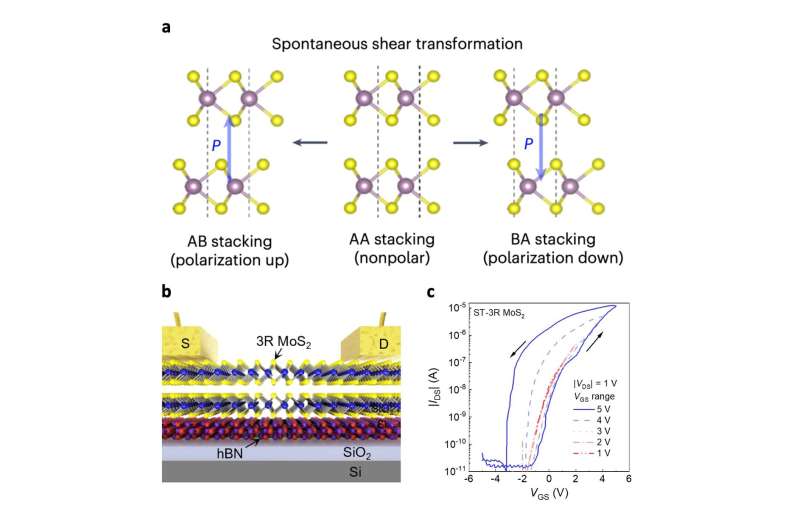December 23, 2023 feature
This article has been reviewed according to Science X's editorial process and policies. Editors have highlighted the following attributes while ensuring the content's credibility:
fact-checked
peer-reviewed publication
trusted source
proofread
Team develops transistors with sliding ferroelectricity based on polarity-switchable molybdenum disulfide

Over the past few years, engineers have been trying to devise alternative hardware designs that would allow a single device to both perform computations and store data. These emerging electronics, known as computing-in-memory devices, could have numerous advantages, including faster speeds and enhanced data analysis capabilities.
To store data safely and retain a low power consumption, these devices should be based on ferroelectric materials with advantageous properties and that can be scaled down in terms of thickness. Two-dimensional (2D) semiconductors that exhibit a property known as sliding ferroelectricity have been found to be promising candidates for realizing computing-in-memory, yet attaining the necessary switchable electric polarization in these materials can prove difficult.
Researchers at National Taiwan Normal University, Taiwan Semiconductor Research Institute, National Yang Ming Chiao Tung University and National Cheng Kung University recently devised an effective strategy to achieve a switchable electric polarization in molybdenum disulfide (MoS2). Using this method, outlined in a Nature Electronics paper, they ultimately developed new promising ferroelectric transistors for computing-in-memory applications.
"We accidentally discovered numerous parallel-distributed domain boundaries in our MoS2 flakes, coinciding with the time when the experimental confirmation of sliding ferroelectricity in 2D materials was reported," Tilo H Yang, co-author of the paper, told Phys.org. "This discovery inspired us to consider whether this domain-boundary-rich MoS2 can be utilized for the development of ferroelectric memory."
The primary objective of the recent study by Yang and his colleagues was to identify a promising method to directly synthesize epitaxial MoS2 with sliding ferroelectricity. The fabrication strategy they identified ultimately allowed them to create promising new ferroelectric transistors with advantageous characteristics.
"An important stage in the fabrication of our ferroelectric transistors is setting up the 3R-MoS2 channel into a switchable ferroelectric material during the chemical vapor deposition (CVD) growth process," Yang explained. "The formation of domain boundaries in 3R-MoS2 films is necessary to possess the ability to switch polarized domains; however, this is rare in most epitaxial 3R MoS2 films. In the paper, we featured a synthesis strategy to increase the chance of domain boundaries appearing in the material, endowing it the capability of domain flipping in response to the gate voltage."
The researchers evaluated their ferroelectric transistors in a series of initial tests and found that they performed well, exhibiting an average memory window of 7V with an applied voltage of 10V, retention times above 104 seconds and endurance greater than 104 cycles. These results highlight their potential for computing-in-memory applications.
"Our ferroelectric semiconductor transistors feature non-volatility, reprogrammability, and low switching fields sliding ferroelectricity, banking on shear transformation-induced dislocations in our 3R MoS2 film," Yang said. "With a thickness of about two atomic layers, the device is a promising component that can fit into the requirements of state-of-the-art CMOS technology, e.g., sub-3 nm nodes."
In the future, the fabrication strategy proposed by Yang and his colleagues could be used to synthesize other promising 2D semiconducting materials with sliding ferroelectricity. These materials could in turn be used to create new highly performing computing-in-memory devices, contributing to the future advancement of electronics.
"Our work proved the switching ability of epitaxial sliding ferroelectric materials and the applicability of this recently discovered physical property in terms of memory," Yang and Yann-Wen Lan added. "Our epitaxial films hold great potential for the development of large-scale, high-throughput memory devices. With a better understanding of the correlation between switching mechanisms and domain microstructures, we are now moving forward to develop a high switching speed and long retention memory."
More information: Tilo H. Yang et al, Ferroelectric transistors based on shear-transformation-mediated rhombohedral-stacked molybdenum disulfide, Nature Electronics (2023). DOI: 10.1038/s41928-023-01073-0
Journal information: Nature Electronics
© 2023 Science X Network



















